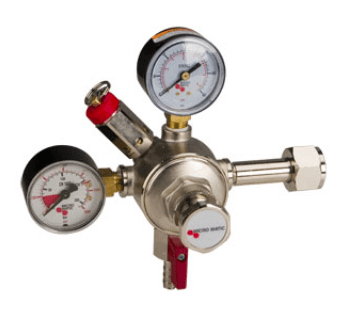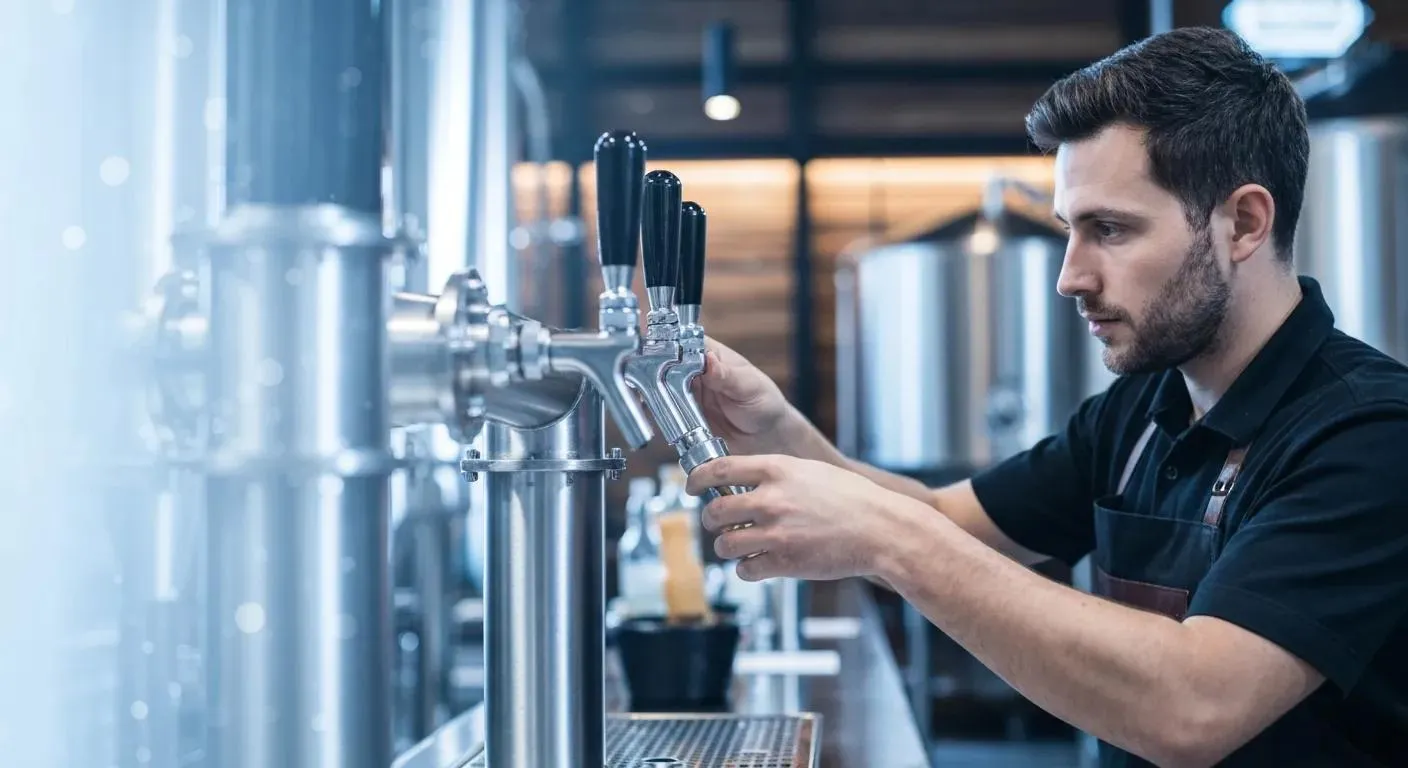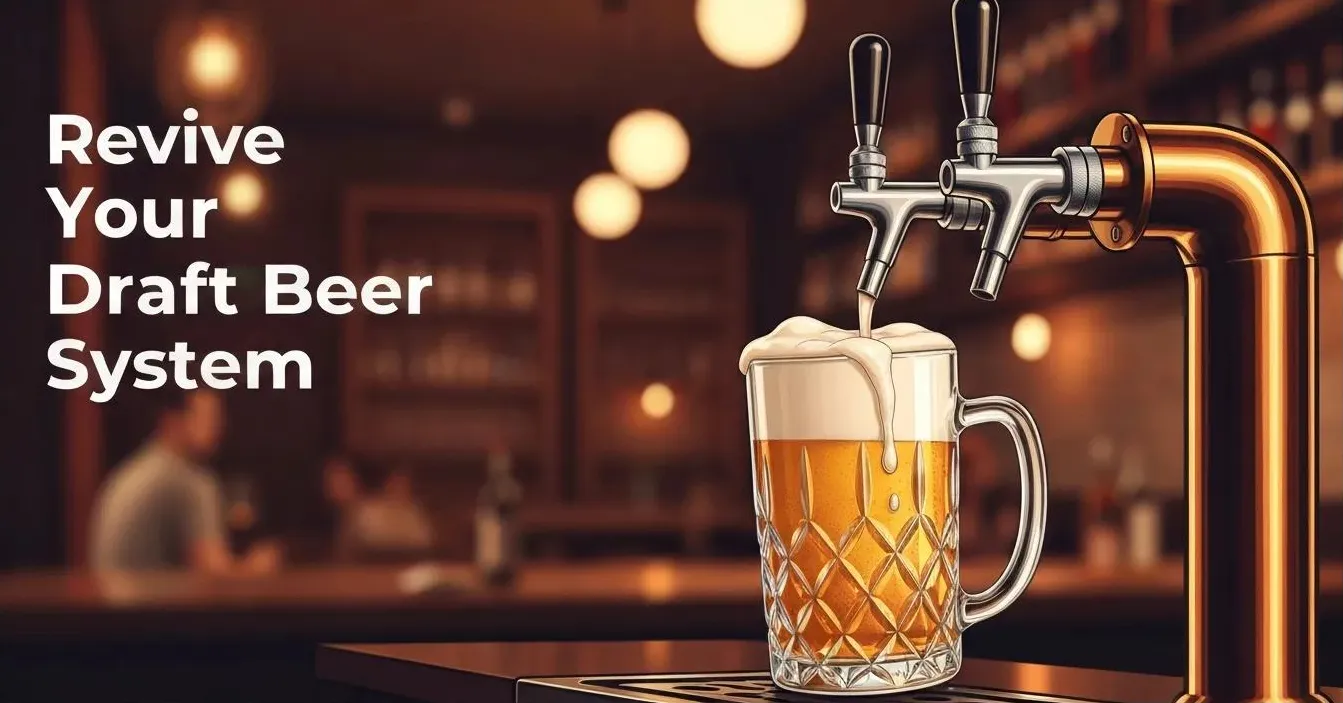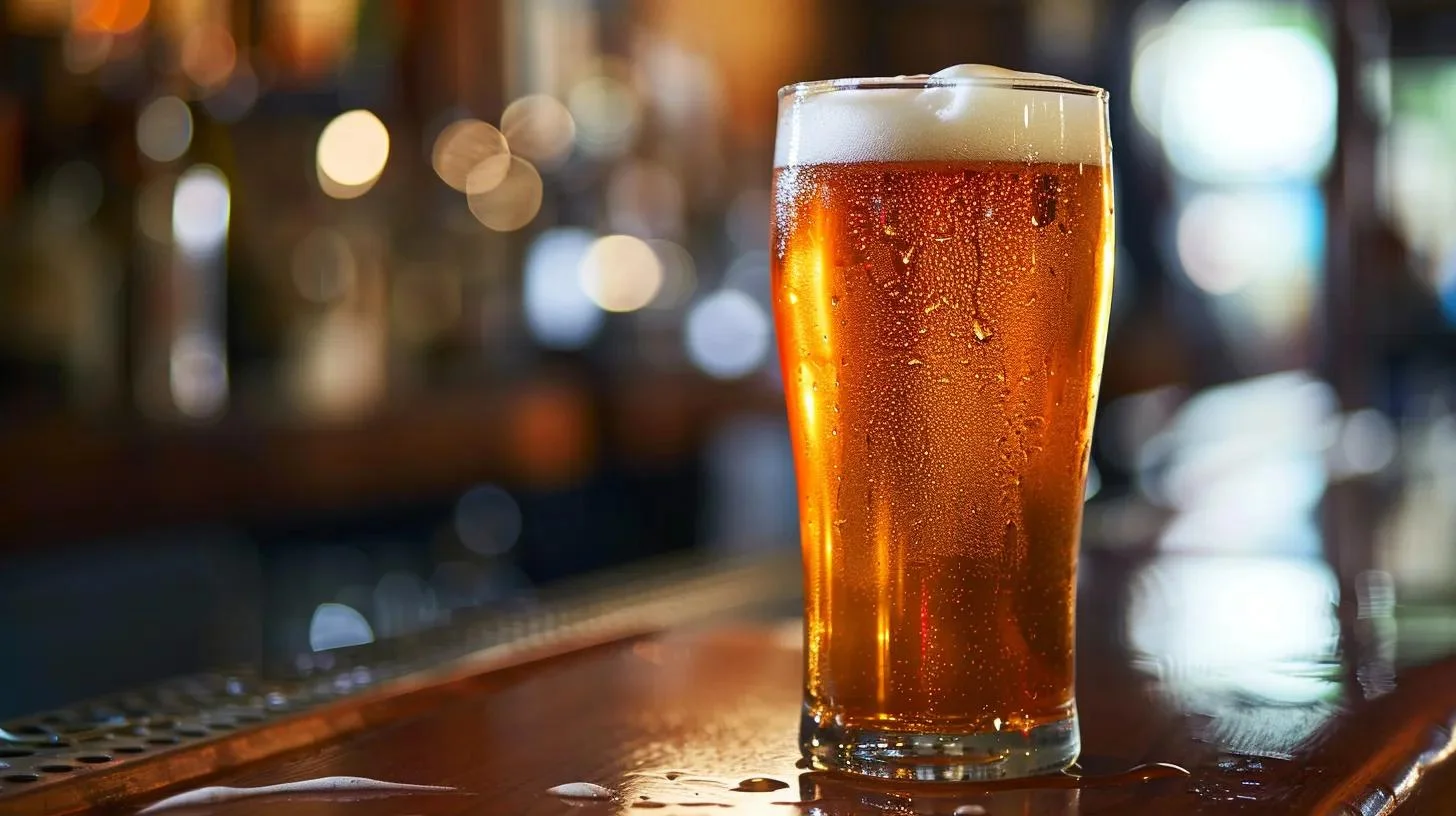Direct Draw Beer System: The Ultimate Guide for Bars and Restaurants

A direct-draw beer system is a popular choice for serving draft beer in bars, restaurants, and other establishments. It's one of 3 types of draft beer systems.
- Air Cooled
- Direct Draw
- Remote or Long Draw System
This system is self-contained, one option is in a refrigeration unit that stores one or more kegs of beer. The other is in a walk-in cooler operating at an optimum temperature of 38° F. The beer is then dispensed through a faucet directly connected to the cooler box or a tower that is connected to a coupler in a self-contained, or walk-in cooler box.Direct draw beer systems are easy to install and work best in establishments or restaurants looking for an economical option. The short distance from the keg to the glass typically means that the beer stays cold at beer temperature and fewer complications can arise.These systems are available in various sizes, from single commercial keg boxes to multiple kegs, depending on the needs of the establishment.Direct Draw system offers a bar owner, restaurant manager, or home brewer, a beer dispensing system that's an excellent option to serve fresh and cold draft beer, as well as other products.In the following sections, we will discuss the components of a direct draw system, how it works, and the benefits of using this system.
What is a Direct Draw Beer System?

A direct draw beer system is a type of draft beer system that is commonly used in commercial settings to dispense keg beer. Think of a commercial Kegerator box with 1 or 4 beer faucets coming out of it. Or Faucets mounted on a wall dispensing cold beer.The direct draw beer system consists of several components, including a refrigerated cabinet/cooler, a carbon dioxide (CO2) tank, a regulator, a beer line, a faucet/shank, and a keg coupler.These components work together to keep the beer at the correct temperature and pressure and to deliver it delivering draft beer down to the faucet.One of the main advantages of a direct draw beer system is that it is easy to install and maintain. It does not require any special equipment, and it can be easily serviced by a qualified technician.Additionally, this system is very efficient and can deliver beer cold quickly and consistently, which is important in a busy commercial setting.
Types of Direct Draw Beer Systems
There are different types of direct draw draft beer systems, that are commonly used in bars and restaurants. Each straightforward draft beer system has its unique features and benefits, and choosing the right one depends on the specific needs and requirements of the establishment. The three most common types of direct draw beer systems are
- Wall Mount Beer Systems
- Kegerators,
- Jockey Boxes
Wall Mount Beer System

A wall-mount beer system is a direct draw system that is mounted on a wall of a walk-in cooler. It is a space-saving option that is ideal for small establishments or bars with limited space.
This system has a refrigeration unit or walk-in cooler that keeps the beer keg cool and a beer tower that dispenses the beer, or a beer faucet attached to the wall.
If using a beer tower, the tower is mounted on the wall, and the beer lines run from the keg to the beer tower connected through the wall. With a forced air system and circulated cold air.
This tap system is easy to install, and it can be customized to fit the specific needs of the establishment.
Kegerator

A kegerator is a direct draw system that is built into a refrigerator. It is a popular option for home bars and small establishments.
This system has a refrigeration unit that keeps the beer keg cool and a front beer cooler tower that dispenses the cold beer. The beer lines run from the keg to the on-draft beer tower through the refrigerator.
Kegerators come in different sizes and styles, and they can be customized to fit the specific needs of the establishment.
Jockey Box

A jockey box is a portable direct draw system that is used for outdoor events or parties. It is a popular option for catering companies, food trucks, and outdoor festivals.This system has a cooler that keeps the beer keg cool and a beer coil that dispenses the cold beer within.
The beer lines run from the keg to the coil through the cooler wall. Jockey boxes come in different sizes and styles, and they can be customized to fit the specific needs of the establishment.
Components of a Direct Draw Beer System
A direct-draw beer system consists of several components that work together to deliver cold, fresh beer from the keg to the tap. Here are the main components of a direct-draw beer system:
CO2 Tank and Regulator

The CO2 tank and regulator are essential components of a direct-draw beer system. The CO2 tank stores the carbon dioxide gas that is used to carbonate the beer and push it through the beer lines. The regulator controls the pressure of the CO2 and ensures that the beer is dispensed at the correct pressure.
The CO2 tank and regulator should be kept in a cool, dry place and should be checked regularly to ensure that they are functioning properly.
Beer Lines and Fittings

The beer lines and fittings are the tubes and connectors that transport the beer from the keg to the faucet. They should be made of food-grade materials and should be cleaned regularly to prevent bacteria buildup. We use XFM for our beer lines instead of vinyl. You can also use 304 stainless lines.
The length and diameter of the beer lines can affect the quality of the pour, so it is important to choose the right size and length for your system. The fittings should be tight and secure to prevent leaks.
Keg Coupler

The keg coupler is the device that connects the beer keg to the beer lines. It has a valve that controls the flow of beer and a probe that punctures the keg to allow the beer to flow.The keg coupler should be compatible with the type of keg you are using and should be cleaned and sanitized regularly to prevent contamination.
Faucet and Shank

304 Stainless Regular Faucet

Stainless Steel Beer Shank for Beer Cooler 6 1/8"The beer faucet and shank are the parts of the system that dispense the beer into the glass. The faucet is the handle that is pulled to release the beer dispensing faucet, and the shank is the metal tube that connects the faucet to the beer line.
The faucet and shank should be made of high-quality materials and should be cleaned and sanitized regularly to prevent contamination.
Drip Tray

The drip tray is part of the system that catches any spilled beer or foam. It is usually located beneath the faucet and shank and should be easy to remove and clean.
The drip tray should be cleaned regularly to prevent bacteria buildup and should be large enough to catch any spills.
Installation and Maintenance Of a Direct Draw Beer System
Direct-draw beer systems are popular in bars and restaurants because they are easy to install and maintain. Proper installation and maintenance are crucial to ensure the system operates at peak performance and delivers high-quality beer.
This section will cover the two main aspects of installation and maintenance: assembly and installation, and cleaning and maintenance.
Assembly and Installation
Assembly and installation of direct-draft systems to draw beer systems should be done by professionals to ensure proper installation and avoid any damage to the system. The installation process of direct draw systems involves several steps, including:
- Choosing the right location for the system
- Installing the beer tower or faucets
- Connecting the beer line and gas line to the couplers
- Testing the system for leaks and proper operation
- Setting the regulators or regulator to the right applied pressure
- Tapping the kegs to pour beer.
Once the system is installed, it is essential to ensure that the beer is at the correct temperature. The temperature should be between 36-38°F, and the pressure should be between 12-14 PSI for most beers.
Cleaning and Maintenance
Cleaning and maintenance are critical to ensure the longevity of any beer system and the quality of the beer. The system should be cleaned regularly to remove any buildup of bacteria, yeast, or mold that can affect the taste of the beer. The cleaning process involves several steps:
- Disconnecting the beer and gas lines
- Removing the faucets and setting up jumper lines.
- Coupling the couplers in the Walk in cooler.
- Cleaning the beer lines and faucets with a cleaning solution
- Rinsing the lines and faucet with clean water
- Testing the water PH to make sure all the chemical is gone.
- Reassembling the system, testing for proper operation, and filling the system with beer.
It is recommended to clean the system every two weeks. In addition to regular cleaning, it is essential to perform routine maintenance, such as checking the CO2 tank pressure and replacing any worn or damaged gasket parts.
By following proper installation and maintenance procedures, direct draw beer systems can provide years of reliable service and high-quality beer.
Advantages of a Direct Draw Beer System
Freshness and Quality
A direct-draw beer system is a great option for businesses that have multiple beer lines and want to maintain the freshness and quality of their beer.
With a direct-draw tap system used, beer is stored in a refrigerated unit and is dispensed through a short, insulated line directly to the tap. This means that the beer is always kept at the optimal temperature, ensuring that it tastes fresh and delicious.
Additionally, because the beer is dispensed directly from the keg, there is minimal points of failure. This is especially important for businesses that serve a high volume of beer, as it ensures that each pint is as fresh and flavorful.
Customization and Flexibility
A direct-draw beer system also offers businesses a high degree of customization and flexibility. With a direct-draw system, businesses can easily switch out beer kegs and offer a wide variety of beer options to their customers.
This is especially important for businesses that want to offer seasonal or specialty beers, as it allows them to quickly and easily rotate their beer selection.
Additionally, because a direct-draw system requires minimal space and equipment, it can be easily installed in a variety of locations, giving businesses greater flexibility in how and where they serve their beer.
Cost Savings
Finally, a direct-draw beer system can also offer businesses significant cost savings over other types of beer systems. Such as a long draw system. Because a direct-draw system is relatively simple and requires minimal equipment, it is often less expensive to install and maintain than other types of beer systems.
Additionally, a direct-draw system dispenses beer directly from the keg, and there is minimal waste, which can help businesses save money on beer costs over time.
This is especially important for businesses that serve a high volume of beer, as it can help them maximize their profits and minimize their expenses.
Conclusion
Direct-draw beer systems are an excellent option for businesses that want to serve draft beer without investing in a complex, draft beer system. These systems are easier to install, cost-effective, and require minimal maintenance. They are also highly efficient, with minimal beer waste during the cleaning and pouring process.
When choosing a direct draw beer system, it is important to consider factors such as the number of taps, draft beer tower, the size of the kegs you will be using, and the amount of keg storage space you have available. You should also pay attention to the temperature at which the keg temperatures your beer will be dispensed, as this can affect the flavor and quality of the beer.
Overall, direct-draw draft beer systems offer a straightforward, reliable way to serve draft beer in a variety of settings and help you provide your customers with a refreshing, consistent temperature high-quality beer experience.



